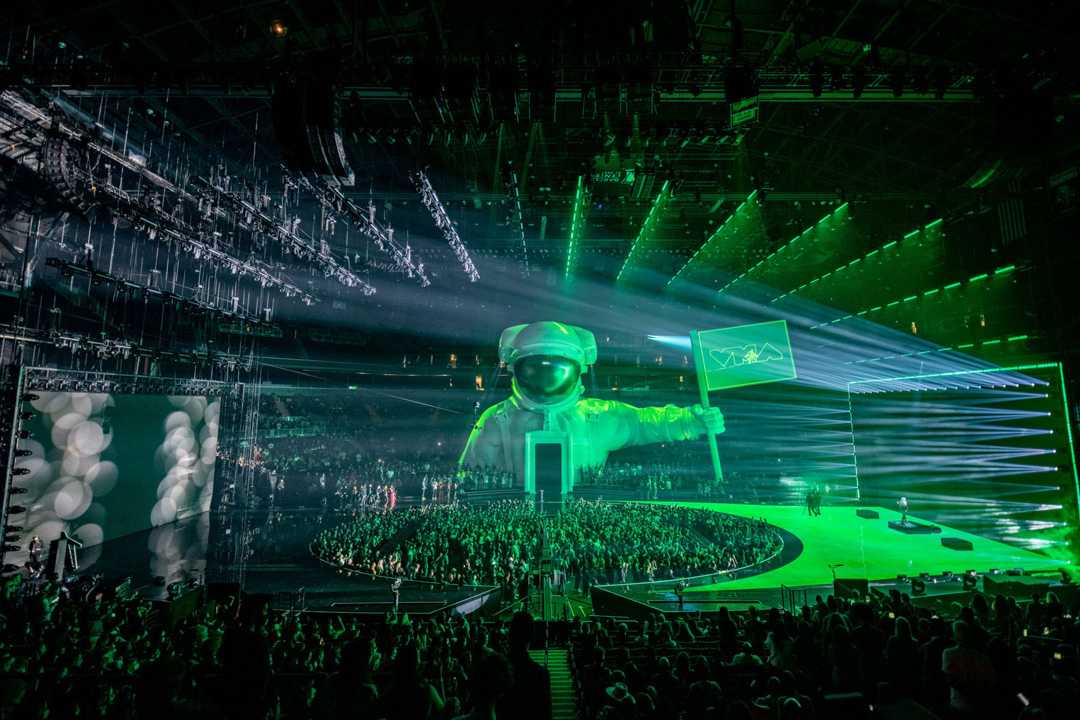Robe lights 2021 Video Music Awards
- Details

Lighting designer Tom Sutherland of DX7 Design worked closely with a team including creative director Paul Caslin, camera director Joe Demaio and set designer Julio Himede of Yellow Studio. Over 300 Robe moving lights featured.
The Robe count included 204 BMFL WashBeams, 80 MegaPointes and 50 Pointes which graced the rig together with a 16-way RoboSpot remote followspot system.
Last year was Tom’s first lighting this high-profile entertainment industry event and 2020 had also been special as it was the only VMAs to be staged virtually with an array of remote performances.
This year, Tom’s starting point for lighting was Julio’s striking set which included a 45ft high inflatable astronaut towering above the long side of the stadium. The figure mimicked the popular VMA logo and awards statues introduced in 2017, inspired by images from various moon landings, and was brought to life for the show with video mapping.
The main artist entrance / exit point was through the astronaut’s chest, with two full stages built left and right of this, directly opposite one another, each occupying one entire end of the event space, with everything connected by an elegant 360-degree oval-shaped catwalk.
The catwalk was constructed from video floor panels which looked stunning in the overhead and crane shots, and it circled a sunken ‘golden circle’ pit, packed with ecstatic fans for the broadcast. There was a smaller circular performance space right in the centre of the pit, so Tom needed key and effects lighting literally everywhere and from every angle to catch all the tightly choreographed live action and the fast-paced presentations, ensuring every shot looked fabulous.
“As always, it was a careful balance of making the house look awesome whilst also satisfying the demands and wishes of the various artists’ creative directors,” he explained.
Fourteen trusses were installed in the roof space above the two stages, flown at different heights so they formed a dome-like shape with the highest trimmed at 70 feet. Most of the lighting was rigged on these trusses, including the BMFL WashBeams.
More BMFL WashBeams were on two long ‘offstage’ trusses that traversed the room lengthways both sides with angled end pieces.
MegaPointes framed three sides of each of the two screens blasting through scenic pros arch surrounds, creating big bold beamy looks and tunnels, cones and slices of fragmented light shooting all around the arena, and there was a 12 x BMFL WashBeam floor package also available on each stage.
Pointes were deployed around the inner perimeter of the ovular catwalk with another 10 Pointes each side flanking the astronaut.
For getting key lighting in exactly the right places, Tom found the RoboSpot system a precision solution.
Ten of the 16 RoboSpot systems controlled 10 BMFL FollowSpot LTs (with the integral camera) rigged on the ‘dome’ trusses which were trimmed too high for human follow spot operators to be working safely.
In addition to these, three upstage BMFL Spots per stage were controlled by the other six RoboSpot systems, making up the total of 16 systems.
The local crew operators had control of iris, dimmer and movement, everything else was done via the main lighting console, and spots were called by conventional light console operator Brian Jenkins, also one of Tom’s programmers.
In addition to Brian, also on Tom’s lighting team were directors Hunter Selby, James Coldicott and Jasmine Lesane plus programmer Joe Holdman who all worked on the grandMA2 control system.
Lighting kit was supplied by Solotech, Harry Forster and Dave Evans were the account managers, the lighting gaffer was Alen Sisul and the techs were Dennis Sisul & John Cox. Head rigger was Brian Lolly of Kish Rigging who Tom compliments for the department’s “amazing” work.
The executive producers were Bruce Gillmer, Jesse Ignjatovic and Barb Bialkowski with Alicia Portugal the executive in charge.












